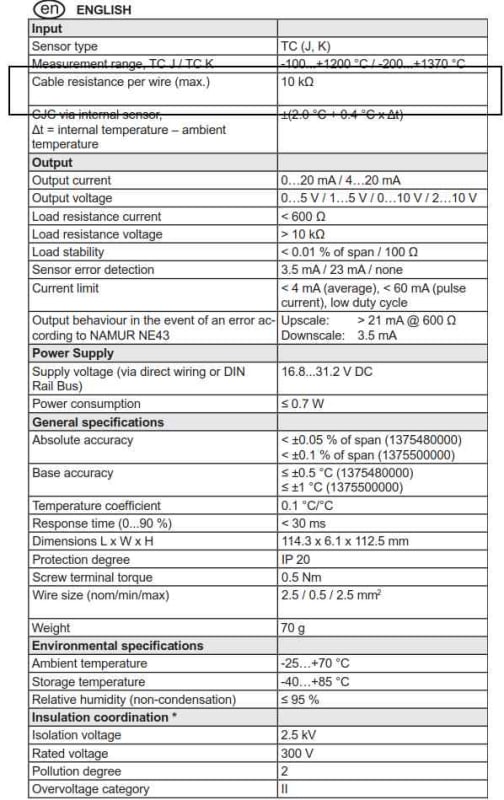DrDrreeeaaa
Electrical
Hi All,
We have a classic thermocouple issue as follows:
1) 10-off K-type 0-1100 deg C thermocouples 500m long connected to...
2) Non-isolated thermocouple converter with...
3) 4-20mA output from converter to a DCS/PLC.
4) The thermocouples are ungrounded, metal sheathed with a lead to lead resistance of ~2-4k ohm.
5) The thermocouple converters and DCS/PLC are housed in a stand-alone solar powered control panel with a DC battery bank, solar charge controller, and small PV array, providing DC power for the system. The DC power system is unearthed.
6) The hot junction is at the bottom of a well, from where the metal sheathed thermocouple wire comes to the surface where it is extended via a potted connection to a thermocouple extension cable. The extension cable is not shielded.
7) The metal sheaths of the thermocouples are all unintentionally bonded together and to the metalwork by what is probably a relatively high resistance connection (they are all just touching each other and the cable tray they are ran on) but there is no proper low impedance ground connection (i.e. bonding of the sheath).
8) The DCS/PLC panel has a floating DC supply and we are not sure if the chassis of the panel is connected to the bonding system (i.e. cable tray, etc).
All thermocouple 4-20mA values fluctuate significantly (from +200% to -200% of the expected temperature within 30 seconds). There is even a thermocouple which is not down the well, it is just coiled up on the ground adjacent the cabinet, which exhibits the same behavior. This behavior coincides with the daylight hours which has led to the suggestion that solar charging is initiating the issue. In addition, the solar charging has been enabled and disabled and the malfunction disappears and reappears accordingly.
The charger has the ability to switch from fast-switching regulation (10KHz) to slow switching (<10Hz) and this has been implemented but it has not improved the situation.
Things I am considering trying next are:
1) To reduce potential for ground loops, ensuring the whole system is at the same potential by improving the bonding across the cable route, since it is not possible to isolate the thermocouple sheaths from the bonding system along their lengths.
2) Making a low impedance connection from each thermocouple sheath to the bonding system, i.e with a sheath bonding wire.
3) Grounding the 0V of the DC supply, so that any noise which is radiated onto the chassis or frame has a better return path to the source.
Any ideas?
We have a classic thermocouple issue as follows:
1) 10-off K-type 0-1100 deg C thermocouples 500m long connected to...
2) Non-isolated thermocouple converter with...
3) 4-20mA output from converter to a DCS/PLC.
4) The thermocouples are ungrounded, metal sheathed with a lead to lead resistance of ~2-4k ohm.
5) The thermocouple converters and DCS/PLC are housed in a stand-alone solar powered control panel with a DC battery bank, solar charge controller, and small PV array, providing DC power for the system. The DC power system is unearthed.
6) The hot junction is at the bottom of a well, from where the metal sheathed thermocouple wire comes to the surface where it is extended via a potted connection to a thermocouple extension cable. The extension cable is not shielded.
7) The metal sheaths of the thermocouples are all unintentionally bonded together and to the metalwork by what is probably a relatively high resistance connection (they are all just touching each other and the cable tray they are ran on) but there is no proper low impedance ground connection (i.e. bonding of the sheath).
8) The DCS/PLC panel has a floating DC supply and we are not sure if the chassis of the panel is connected to the bonding system (i.e. cable tray, etc).
All thermocouple 4-20mA values fluctuate significantly (from +200% to -200% of the expected temperature within 30 seconds). There is even a thermocouple which is not down the well, it is just coiled up on the ground adjacent the cabinet, which exhibits the same behavior. This behavior coincides with the daylight hours which has led to the suggestion that solar charging is initiating the issue. In addition, the solar charging has been enabled and disabled and the malfunction disappears and reappears accordingly.
The charger has the ability to switch from fast-switching regulation (10KHz) to slow switching (<10Hz) and this has been implemented but it has not improved the situation.
Things I am considering trying next are:
1) To reduce potential for ground loops, ensuring the whole system is at the same potential by improving the bonding across the cable route, since it is not possible to isolate the thermocouple sheaths from the bonding system along their lengths.
2) Making a low impedance connection from each thermocouple sheath to the bonding system, i.e with a sheath bonding wire.
3) Grounding the 0V of the DC supply, so that any noise which is radiated onto the chassis or frame has a better return path to the source.
Any ideas?



